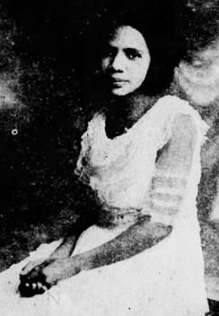Lodie M. Biggs
Lodie M. Biggs | |
|---|---|
 Lodie M. Biggs, from a 1921 publication. | |
| Born | Lodie Maurine Biggs March 1, 1895 Little Rock, Arkansas |
| Died | March 1971 Brooklyn, New York |
| Nationality | American |
| Other names | Lodie Biggs Moore (after 1950) |
| Occupation(s) | Bacteriologist, activist |
| Years active | 1928-1971 |
| Spouse | Richard B. Moore |
Lodie Maurine Biggs (March 1, 1895 – March 1971), later Lodie Biggs Moore, was an American bacteriologist, bookseller, and civil rights activist.
Early life[edit]
Lodie Maurine Biggs was born in Little Rock, Arkansas, and raised in Seattle, Washington. Her father worked for the railroad, and was a member of the IWW.[1] She earned a bachelor's degree in chemistry at the University of Washington in 1916.[2][3]
Career[edit]
Bacteriology[edit]
Biggs worked as a bacteriologist at Crescent Biological Laboratory in Seattle.[4] She also worked for the city of Seattle and the state of Washington, and ran her own commercial laboratory.[5] In the 1930s, she moved to New York, and worked as a city bacteriologist there.[1][6]
Activism in Seattle[edit]
In 1928, Biggs helped to revive the dormant Seattle branch of the NAACP, serving as its president from 1928 to 1930, and helped found and lead the Seattle branch of the National Urban League.[7][8] In 1931, she attended the annual convention of the National Urban League in Minneapolis.[5]
In 1932, she offered to resign from the Seattle Urban League's Health and Recreation Committee, when it moved to sponsor an all-black baseball team, which she felt was counter to the goal of racial integration: "Separate teams mean the beginning of racial feeling," she explained, "I do not approve and do not wish to be connected with an organization that would foster such a movement." Instead, the committee's chair agreed that she had a point, and set a policy against segregated teams.[9]
Activism in New York City[edit]
By 1937, she was living in New York, and was secretary of the Harlem Citizens' Committee to Aid the Striking Seamen.[10] She also served on the committee that became the Harlem Tenants Association that year.[11] In 1942, she worked with Richard B. Moore, the Barbadian-born writer and activist based in Harlem. Biggs and Moore were both members of the Harlem section of the Communist Party, and both were expelled from the Party. In 1942, the pair founded the Frederick Douglass Book Center, a bookstore and community space in Harlem.[1] [12]
Personal life[edit]
Lodie Biggs married Richard B. Moore as his second wife in 1950;[13] they shared an apartment in Brooklyn until her death there in 1971, in her seventies.[1]
References[edit]
- ^ a b c d Moore, Richard Benjamin; Turner, W. Burghardt; Turner, Joyce Moore (1988). Richard B. Moore, Caribbean Militant in Harlem: Collected Writings, 1920-1972. Indiana University Press. pp. 69–70, 94. ISBN 978-0-253-31299-0.
- ^ "A Coming Woman". Cayton's Monthly. 1921-02-01. p. 12. Retrieved 2020-02-18 – via Newspapers.com.
- ^ "Northern Colleges". The Crisis. The Crisis Publishing Company, Inc. July 1922. p. 114.
- ^ Weinzirl, John (1929). "The Science of Bacteriology in the State of Washington". The Washington Historical Quarterly. 20 (2): 87. ISSN 0361-6223.
- ^ a b "Bacteriologist". The Chicago Defender. July 11, 1931. p. 6 – via ProQuest.
- ^ Terborg-Penn, Rosalyn. (2009). "Complexities of race, class and gender in reconstructing identities: Afro-Cuban and Afro-American immigrant oppositional strategies to racism in the twentieth century" The Journal of Caribbean History, 43(2), 227-IX.
- ^ Taylor, Quintard (November 1991). "Blacks and Asians in a White City: Japanese Americans and African Americans in Seattle, 1890-1940". Western Historical Quarterly: 417. ISBN 9780815334576.
- ^ "National Association for the Advancement of Colored People, Seattle Branch photograph collection, circa 1960s-1980s". Archives West. Retrieved 2020-02-18.
- ^ Taylor, Quintard (2011-07-01). The Forging of a Black Community: Seattle's Central District from 1870 through the Civil Rights Era. University of Washington Press. pp. 92–98. ISBN 978-0-295-80223-7.
- ^ "Harlem Group Plans to Aid Ship Strikers at 2-Day Conference". The New York Age. 1937-01-23. p. 2. Retrieved 2020-02-18 – via Newspapers.com.
- ^ Wright, Richard. "Negro Tenants Win Rent Cuts in 8 Houses" The Daily Worker (November 23, 1937). Reprinted in Earle V. Bryant, ed., Byline, Richard Wright (University of Missouri Press 2015): 61-62. ISBN 9780826273178
- ^ Makalani, Minkah. "Black Women's Intellectual Labor and the Social Spaces of Radical Thought in Harlem" in Andrew M. Fearnley, ed., Race Capital? Harlem as Setting and Symbol (Columbia University Press 2018). ISBN 9780231544801
- ^ Moore, Richard B. (1992). The Name "Negro": Its Origin and Evil Use. Black Classic Press. p. 19. ISBN 978-0-933121-35-5.
